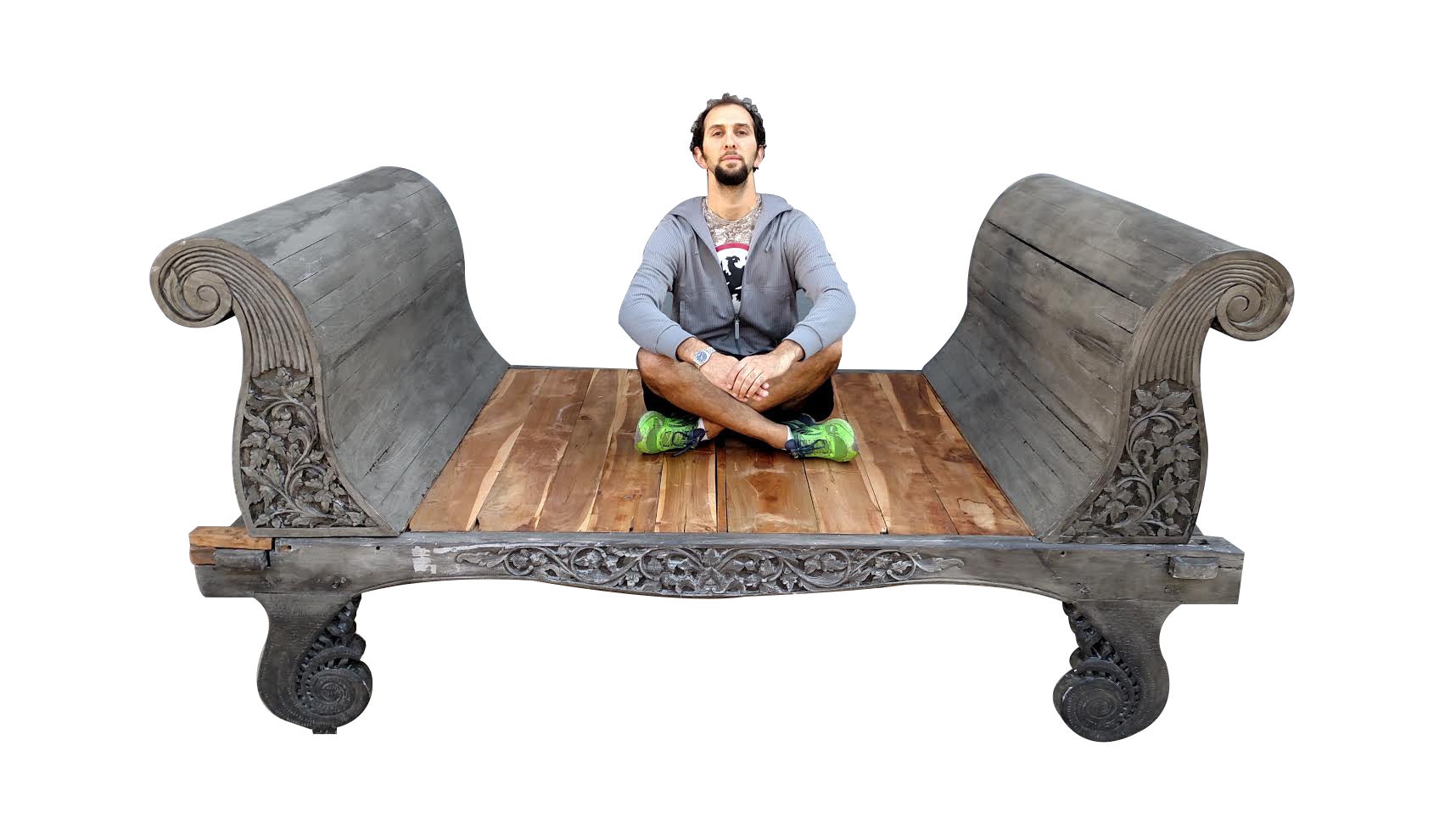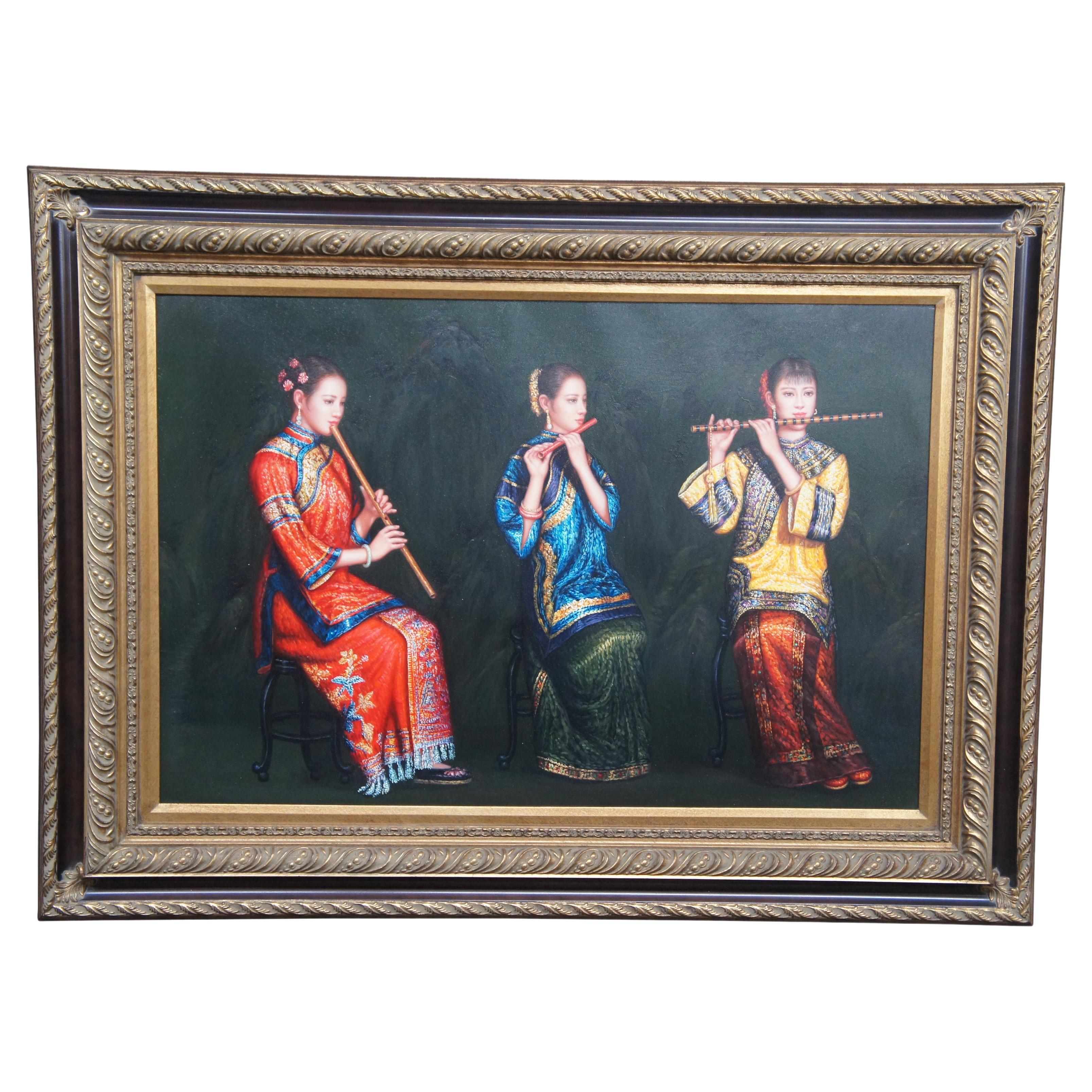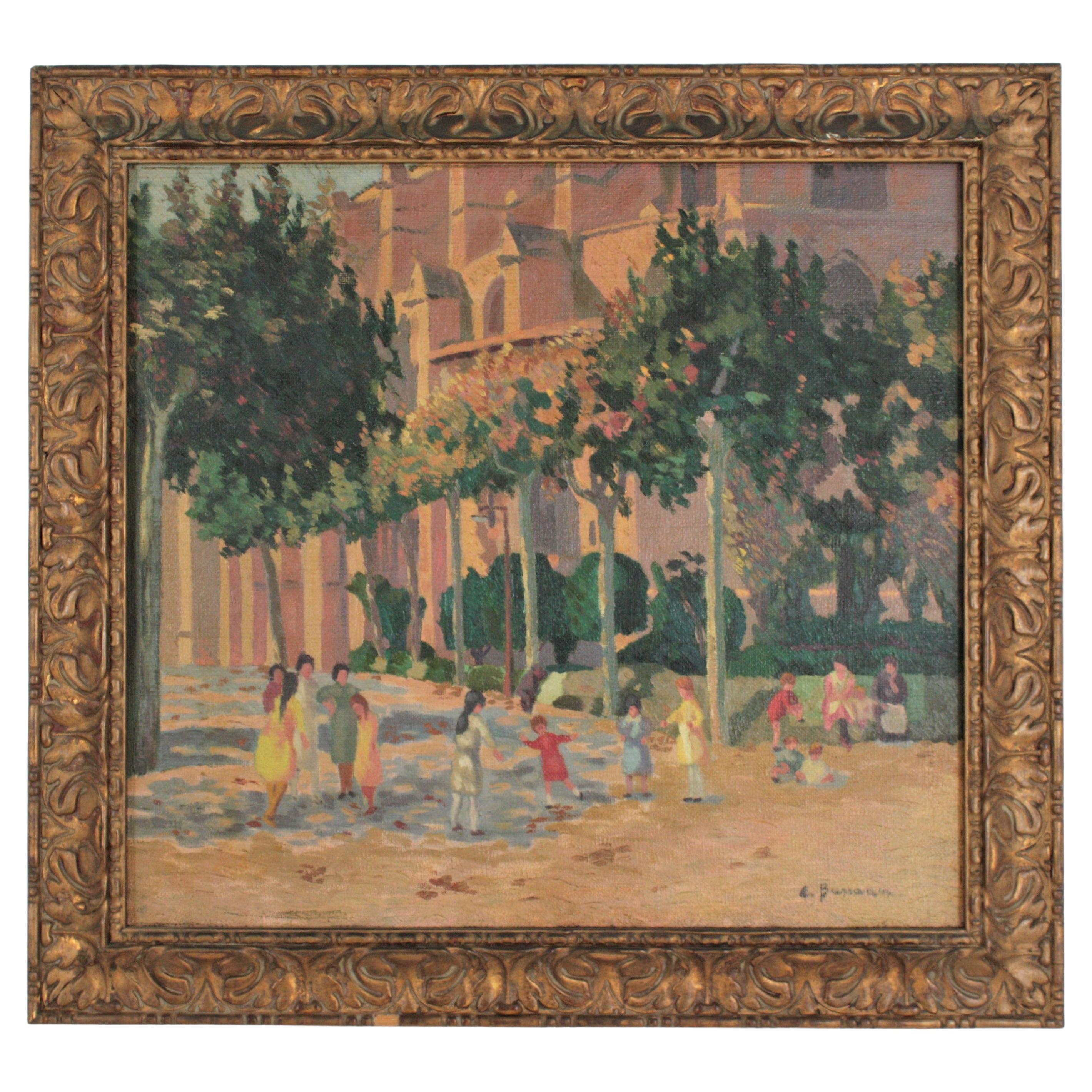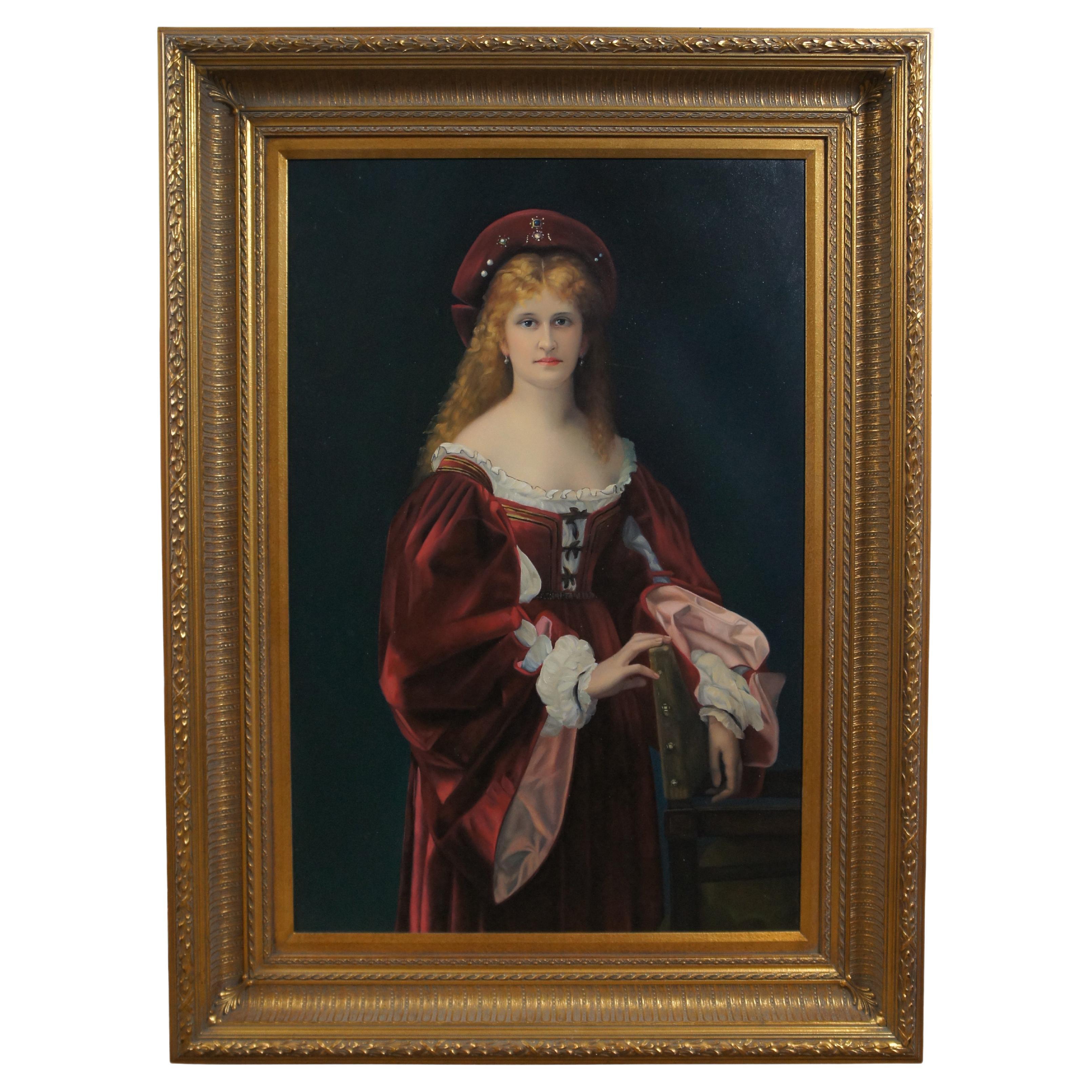Items Similar to Chinese Woman Playing Bamboo Flute Oil Painting on Canvas After Chen Yifei 47"
Want more images or videos?
Request additional images or videos from the seller
1 of 13
Chinese Woman Playing Bamboo Flute Oil Painting on Canvas After Chen Yifei 47"
About the Item
Vintage Chinese woman playing flute oil painting on canvas after Chen Yifei. Features a young musician in traditional court attire playing the Dizi / bamboo flute.
Chen Yifei (Chinese: 陈逸飞; April 12, 1946 – April 10, 2005) was a renowned Chinese classic-style painter, art director and film director. He has made many films such as The Music Box and Inyak Twilight.
Achievements
Chen Yifei is a central figure in the development of Chinese oil painting. He is also considered one of China's most renowned contemporary artists.[citation needed] Although denounced for "capitalist behavior", Chen's work with oil painting earned him recognition from Chinese authorities.
Chen soon became one of the leading painters of the Cultural Revolution. He was famous for his Mao Zedong portraits and depiction of grand heroic events of the modern Chinese nation. Since the Cultural Revolution, Chen became the forerunner of a new age in Chinese aesthetics, promoting a new sense of modernity and lifestyle in his paintings, including fashion, cinema and design. In his oil paintings, Chen abandoned his uncritical glorification of the party to blend realistic technique and romanticism with Chinese subject matter, especially melancholic and lonely women in traditional dresses. His characteristic "Romantic Realism" paintings use dark and dense colors and convey a sense of richness and integrity.
In 1980 he became one of the first artists from the People's Republic of China permitted to study art in the United States. Wally Findlay Galleries was the first gallery to grant Chen Yifei an exclusive contract. Chen Yifei enrolled at Hunter College and later found work as an art restorer. In 1983, before he attained his master's degree at Hunter, his solo exhibition at the Hammer Galleries was a great success. Later, he established himself as a contract artist for the Hammer Galleries.
Chen returned to China and settled in Shanghai in 1990. He painted Impressionist landscapes of Tibet and his native Zhejiang Province. At the same time, he had also transformed himself into a style entrepreneur, creating fashion brands, decorating hotels and selling high-end clothing and chic home furnishings. He also supervised one of the country's biggest modeling agencies. Some critics said he turned increasingly commercial. In 2005, while working on a feature film, "Barber," Chen fell ill and died.
Style and content
Chen worked primarily in oil painting which portrayed his sense of romanticism and realism combined. His works frequently featured beautiful women in traditional Chinese attire working with musical instruments or other romanticized objects. There are many examples of this brand of paint including Young Cellists (1984) and Two Women and Fan (2003). Other works featuring Chinese women in traditional clothing include Beauty (Blue/Red) (1998), Beauty with Fan (2002), Group of Beauties with Fans (2004), Seated Beauty with Fan (1998), and Reclining Beauty (1997)[5] The realism of Chen's works often evokes a photographic or cinematic feeling, inspired by the framing, lighting and positioning of the paintings.
In addition to painting the female form, some of Chen's earlier works were often more impressionistic landscape paintings done in his style, such as his piece Shadow from 1983 in which a scene of a canal in absence of human life is painted in muted tones. Chen first received inspiration for these works when he travelled to Europe in the summer of 1982 and toured the canals, noting similarities in the ambiance between the East and West. He later returned to Zhejiang and studied, what he considered, the "Venice of the East" for more inspiration.[6] His landscapes often featured similar scenes of canals inspired by the canals of Venice, Italy as well as the canals of his hometown in Zhejiang province.
"Official" art
Chen's artistic career began soon after graduating from the Shanghai College of Art when his realistic style of oil painting caught the attention of Communist officials. Chen painted many famous portraits of Mao in heroic, glorified positions. One of these works, Seizing of the Presidential Palace (1977) received great favor in the Communist party, earning a place in the great halls around China. The picture is a historical epic depiction of a group of soldiers raising a red flag, representative of the history of the Revolution. His work Eulogy of the Yellow River, completed in 1972, is still considered one of his most commercially successful works, featuring his singular techniques in expressive brushstrokes that create a realistic view of a soldier standing above a yellow-toned valley, turned to face the viewer. The work was originally inspired by a poem (written by Guang Weiran) and a song (composed by Xian Xinghai).[6] The work was first presented to the public in 1977 at the United Armies Art Exhibition when Chen was 25 years old.[7] The revelation of this work marked a pivotal point in Chen's artistic career, propelling his art into further success in the future. In 2007, two years after the artist's death, Eulogy of the Yellow River sold at The China Guardian 2007 Spring Auction of Oil Painting and Sculptures for a record high of RMB 40.28 million, breaking both Chen's previous world record high sale and the national record for Chinese oil paintings.[7]
In 1979, Chen painted Looking at History from My Space, a piece that critics consider Chen's work considers "one of his most original works".[1] The painting features the artist standing in front of a large mural of painted events from the 1910s and 1920s, symbolically representing the artist trying to distance himself from history, to examine his place in history.
Realism
Along with his predilection for painting women, Chen painted a series of realistic works featuring people of Tibet; the series was called "Tibet." To gather intelligence and insight into the people and customs of Tibet, Chen spent some time in the 1980s exploring Jiangnan. The works that followed his excursion held to his highly realistic brand of paint, but traveled away from only painting the most beautiful forms of life. His "Tibet" works feature the tanned and coarse Tibetan people with no pretense of activity and muted expressions.[6] One of the most famous works from this series was called Upland Wind (sometimes called Wind of Mountain Village) and was painted in 1994. The painting features a family of Tibetan travelers, heavily clothed and layered (to convey a sense of coldness) in traditional Tibetan styles. The painting was initially auctioned at the China Guardian 1994 Autumn Auctions, selling for a record-high price of 2.86 million Yuan. At the time, this was a record for Chinese oil paintings. In May 2011 the painting was auctioned off for 81.65 million Yuan, beating the record again for highest-selling oil painting as well as beating his record for highest-selling work.[8]
Acclaim and criticism
His works are considered a unique combination of both Western and Eastern influences. Chen's style combines the realism associated with European art styles, with Eastern subject matter and themes close to the artist's history. One such example of this unique blend is his painting Poppy which derives its content from a Tang dynasty song about a woman who solemnly questions her fate. The painting features a Chinese woman in traditional Chinese garb, yet the style of painting coupled with her posture is more reminiscent of ancient Greek artworks than Tang dynasty works. His Eastern-Western fusion of artistic styles is apparent in another of his famous paintings called Soiree, which depicts Chinese musicians in traditional apparel, symbolizing an Eastern theme, but the atmosphere of the painting aligns more with the Western ideal of "carpe diem".[clarification needed][4]
Critics of Chen's work comment that his works lack an edge possibly due to his commercialization. Chen, however, viewed his entrepreneurship and businessman-like approach to art as an extension of what he truly loved: beauty. In answering a question regarding his work, Chen is quoted to have said: "I love paintings, clothing and films because they are all beautiful things".[9]
Dimensions:
34.5" x 46.5", sans 24"x 36"
- Similar to:Chen Yifei (Artist)
- Dimensions:Height: 46.5 in (118.11 cm)Width: 2 in (5.08 cm)Depth: 34.5 in (87.63 cm)
- Style:Chinoiserie (In the Style Of)
- Materials and Techniques:
- Period:
- Date of Manufacture:Late 20th Century
- Condition:Very good.
- Seller Location:Dayton, OH
- Reference Number:

About the Seller
4.9
Platinum Seller
These expertly vetted sellers are 1stDibs' most experienced sellers and are rated highest by our customers.
Established in 2010
1stDibs seller since 2020
1,113 sales on 1stDibs
Typical response time: <1 hour
- ShippingRetrieving quote...Ships From: Dayton, OH
- Return PolicyA return for this item may be initiated within 2 days of delivery.
More From This SellerView All
- Chinese Trio of Woman Playing Bamboo Flutes Oil Painting After Chen Yifei 46"By Chen YifeiLocated in Dayton, OHVintage trio of Chinese woman playing flutes oil painting on canvas after Chen Yifei. Features three young musicians in traditional court attire p...Category
Late 20th Century Chinoiserie Paintings
MaterialsCanvas, Paint
- Chinese Trio of Female Musicians Oil Painting on Canvas After Chen Yifei 44"By Chen YifeiLocated in Dayton, OHVintage trio of Chinese woman playing instruments oil painting on canvas after Chen Yifei. Features three young musicians in traditional court attire playing various instruments. C...Category
Late 20th Century Chinoiserie Paintings
MaterialsCanvas, Paint
- Patrician of Venice After Alexandre Cabanel Portrait Oil Painting on Canvas 47"Located in Dayton, OH#39707 Very large and impressive hand painted reproduction oil portrait painting on canvas after “Patricienne de Venise” (Patrician of Venic...Category
Late 20th Century Elizabethan Paintings
MaterialsCanvas, Paint
- Original Oil Painting on Canvas Lake Scene Water Lily Floral Marsh Realism 47"Located in Dayton, OHOriginal oil painting titled Lake Scene featuring flowers, foliage, trees and water lily's. Signed lower right. art 24" x 36"Category
Late 20th Century Paintings
MaterialsCanvas, Paint
- Antique 18th Century Dutch Oil Painting on Canvas Oval Portrait Seated WomanLocated in Dayton, OH"An impressive early 18th century Dutch School portrait of Carolina Cornelia De Wille, circa 1714. The oval oil painting is on canvas and feat...Category
Antique 1710s Dutch Colonial Paintings
MaterialsCanvas, Paint
- Antique Monks with Spirits Oil Painting on Canvas After Eduard von Grutzner 29"Located in Dayton, OHLate 19th century oil on canvas painting titled "Monks with Spirits," showing a pair of monks with a candle, peering at another monk, sleeping against a barrel, next to a drink pitcher and goblet of wine. Attributed to Adolf Metzner, after the work of Eduard von Grutzner. Adolf Metzner was an Indianapolis pharmacist and artist who served in the Civil War and moved to Hamilton, Ohio where he painted copies of Grutzner's whimsical depictions of monks in everyday life. "Eduard Theodor Ritter von Grützner (1846 - 1925) Born into a land-owning family in Upper Silesia on May 26, 1846, he showed an early interest in painting and drawing and became well known for his figure and genre paintings, especially those of monks. In 1864, with the help of an architect Hirschberg, he left home for art education at the private school of Herman Dyck in Munich. In his first semester, he transferred to the Classical Art class of Johann Georg Hiltensperger and Alexander Ströhuber, where the students learned about the aesthetic ideals of antiquity. In 1865, Grützner joined the painting class of Hermann Anschütz at the Munich Academy. Meanwhile, he also sought advice and inspiration with Carl Theodor von Piloty until he was taken into his class in 1867. Piloty's class was packed with aspiring artists from around the world, from Hungary, Greece, Germany, Russia, and Poland. After three years under Piloty, Grützner left the academy. In 1870 he moved into his own studio in the garden house of Schwanthalerstraße 18 in Munich. He quickly began to produce one painting after another. He made his career in Munich and was very successful. It was reported by artist and writer Friedrich Pecht in the journal Die Kunst für Alle (Art for All) in 1886: "the painters Eduard Grützner and Ludwig Willroider were granted the title of "professor" by Luitpold, Prince Regent of Bavaria. In 1880 he was awarded the Order of Merit of St. Michael (Knight...Category
Antique Late 19th Century Paintings
MaterialsCanvas, Paint
You May Also Like
- Oil on Canvas Painting, Children Playing, 1940sLocated in Barcelona, ESA colorful oil on canvas representing a group of children playing in a garden area near a Cathedral. Framed by a carved giltwood frame with foliage det...Category
20th Century Spanish Mid-Century Modern Paintings
MaterialsWood, Canvas
- Antique Painting, Woman Portrait Painting, Symbolist Painting, Oil on CanvasLocated in Breganze, VIThis is a antique portrait artwork, antique portraits proposes a young girl seen from behind looking at the Sunset is an oil painting on canvas from the late 19th or early 20th cent...Category
Early 20th Century French Art Nouveau Paintings
MaterialsCanvas
- Italian Surrealist Oil Painting on Canvas After ModiglianiBy Amedeo ModiglianiLocated in Houston, TXItalian Surrealist oil painting on canvas after Modigliani. This interesting framed oil painting on canvas with a glass front is of an elongated mal...Category
Vintage 1970s Italian Post-Modern Paintings
MaterialsCanvas, Wood, Paint
- Large Oil on Canvas "Beggar Boys Playing Dice" After Bartolomé Esteban MurrilloBy Bartolomé Esteban MurilloLocated in Los Angeles, CAA fine and large 19th century oil on canvas after Bartolomé Esteban Murrillo's (Spanish, 1617-1682) "Beggar Boys Playing Dice" (The original work by Murillo was painted in 1675). The impressive artwork depicts two young boys playing dice while another eats a piece of fruit as his dog watches on., within an ornate gildwood and gesso frame bearing a label from the faming company Bigelow & Jordan. The original work by Murillo is currently at the Alte Pinakothek Museum in Munich, Germany. The present work is signed: L. Rüber. Circa: Munich, Late 19th Century. Bartolomé Esteban Murillo (born late December 1617, baptized January 1, 1618 – April 3, 1682) was a Spanish Baroque painter. Although he is best known for his religious works, Murillo also produced a considerable number of paintings of contemporary women and children. These lively, realist portraits of flower girls, street urchins, and beggars constitute an extensive and appealing record of the everyday life of his times. Murillo was born to Gaspar Esteban and María Pérez Murillo. He may have been born in Seville or in Pilas, a smaller Andalusian town. It is clear that he was baptized in Seville in 1618, the youngest son in a family of fourteen. His father was a barber and surgeon. His parents died when Murillo was still very young, and the artist was largely brought up by his aunt and uncle. Murillo began his art studies under Juan del Castillo in Seville. There he became familiar with Flemish painting and the "Treatise on Sacred Images" of Molanus (Ian van der Meulen or Molano). The great commercial importance of Seville at the time ensured that he was subject to influences from other regions. His first works were influenced by Zurbarán, Jusepe de Ribera and Alonzo Cano, and he shared their strongly realist approach. As his painting developed, his more important works evolved towards the polished style that suited the bourgeois and aristocratic tastes of the time, demonstrated especially in his Roman Catholic religious works. In 1642, at the age of 26, he moved to Madrid, where he most likely became familiar with the work of Velázquez, and would have seen the work of Venetian and Flemish masters in the royal collections; the rich colors and softly modeled forms of his subsequent work suggest these influences. In 1645 he returned to Seville and married Beatriz Cabrera y Villalobos, with whom he eventually had eleven children. In that year, he painted eleven canvases for the convent of St. Francisco el Grande in Seville. These works depicting the miracles of Franciscan saints vary between the Zurbaránesque tenebrism of the Ecstasy of St Francis and a softly luminous style (as in Death of St Clare...Category
Antique Late 19th Century German Baroque Paintings
MaterialsGesso, Canvas, Wood
- Magical Painting of Boy Playing a FluteLocated in Hopewell, NJA beautifully rendered oil on canvas of a young boy playing a flute in a wonderful mix of dreamy blues and pinks. Signed TKS Original frame gold leaf and ebonized wood.Category
Vintage 1960s North American Paintings
MaterialsCanvas
- Oil on Canvas, French WomanLocated in Munich, DEPainting of a woman in nude. This oil painting was made in France.Category
20th Century Paintings
MaterialsCanvas





